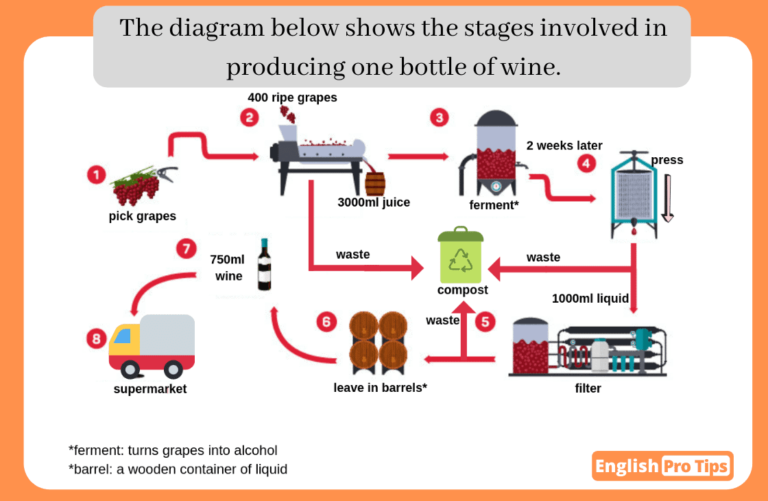The diagram illustrates the step-by-step production process of a 750 ml bottle of wine.
Overall, the whole process consists of eight stages, beginning from grape-picking until delivery to supermarkets. In the early stage, 3000 ml of juice is being pressed, but after undergoing three stages of waste treatment, it is being reduced to 750ml bottle of wine.
The first two stages involve picking up bunches of grapes, from which, 400 pieces are taken to be pressed and eventually produce 3000 ml of juice. Here, some of the solid waste goes to the compost. Next, the grape juice, which is poured into a huge container, is left to ferment for two weeks.
Once the grapes has turned into alcohol, it is ready to go through another pressing to make 1000 ml of liquid. Again, in this stage, some of the residual waste goes to the compost, while the liquid is being stored in the filter to go through a filtering process. Subsequently, in this stage, some of the waste from the filter are taken to the compost for the last time whereas the remaining juice is being taken into wooden containers to age. After leaving the juice in the barrels for some time, it is finally set to be bottled. At last, after bottling the wine, it is then ready to be transported to the stores.




 (1 votes, average: 8.00 out of 9)
(1 votes, average: 8.00 out of 9)
Comments
Very nice answer Noemi.
+ Very clear introduction (brief and to the point)
+ Clear overview (you mention all of the key points)
+ Good structure (you have divided your body into two logical paragraphs)
+ Great non-defining relative clauses
+ Good linking words (it is easy to follow)
– In your report, you use the past continuous tense (juice is being pressed). It would be more appropriate to use the past simple tense as you are describing something that happens regularly.
– Consider a saying “is sent to be composted” sometimes (as an alternative to “goes to the compost”)